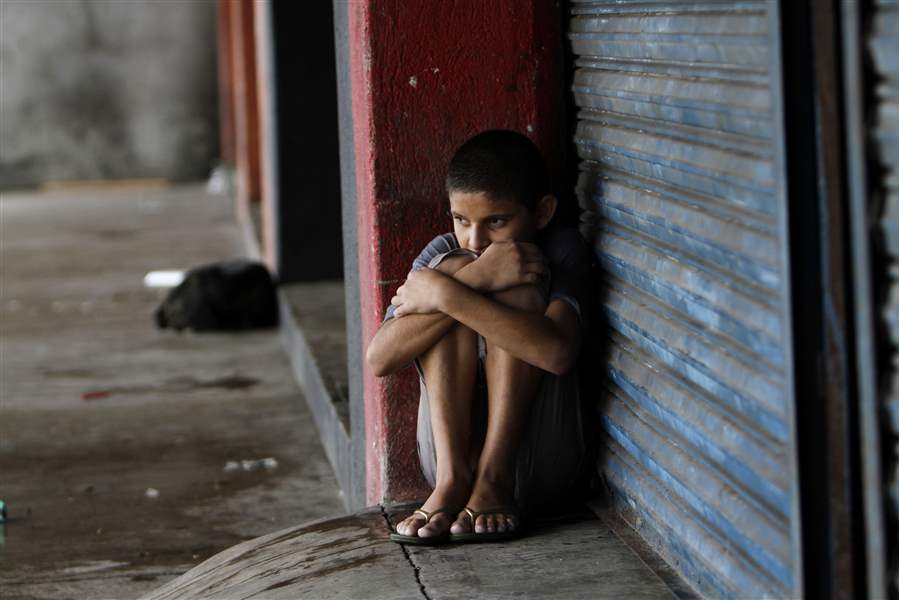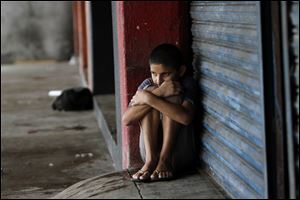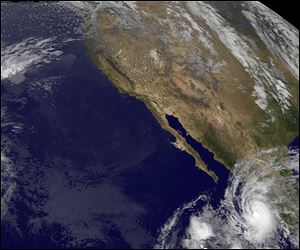
People hunker down in homes, shelters as Hurricane Jova makes nighttime surge into Mexico
10/12/2011
A boy takes shelter from rain Tuesday in front of a store at the harbor in Manzanillo, Mexico.
ASSOCIATED PRESS

A boy takes shelter from rain Tuesday in front of a store at the harbor in Manzanillo, Mexico.
MANZANILLO, Mexico — Hurricane Jova slammed into Mexico's Pacific coast as a Category 2 storm early Wednesday, swamping beach towns and causing floods in the mountains above.
The storm toppled trees, knocked out power and flooded streets in the major port city of Manzanillo, but the full extent of damage was still unclear before dawn Wednesday. There were no immediate reports of deaths.
The U.S. National Hurricane Center said Jova's maximum sustained winds were near 100 mph (160 kph) when it hit, but it was weakening steadily as it moves inland and winds were down to 75 mph (140 kph) by 7 a.m (8 a.m. EDT; 1200GMT).
As the storm's leading rain bands began swatting at the coast Tuesday night, heavy rain fell in Manzanillo, Mexico's second-biggest non-oil cargo port. It was closed to navigation because of the storm.
Callers told local station Radio Turquesa that water was several feet (more than a meter) deep in some neighborhoods and schools, some used for shelters, were closed for the day.
The Hurricane Center in Miami warned that the storm surge could cause significant coastal flooding along the 210-mile (340-kilometer) stretch between Manzanillo and Cabo Corrientes, which is southwest of the resort city of Puerto Vallarta.
Up to 20 inches (50 centimeters) of rain could fall on isolated areas as Jova moves inland, the center said.
Before nightfall Tuesday, marines visited flood-prone areas in Manzanillo to advise people to leave. They found a home for elderly people whose homes were already flooded and evacuated dozens of people to stay with relatives, Adm. Jaime Mejia said. Forty others were evacuated in the nearby town of Tecoman, he said.
Some people vowed to ride out the storm, while others took refuge at shelters in towns like Jaluco, just inland from the beach community of Barra de Navidad.

A satellite image of Hurricane Jova, lower right, taken at 12:30 a.m. EDT Wednesday as it approaches the Mexican coastline with maximum sustained winds of 100 mph.
"My house has a thatch roof, and it's not safe," said Maria de Jesus Palomera Delgado, 44, a farmworker's wife who went to an improvised shelter at a grade school in Jaluco, along with her 17 children and grandchildren.
"The neighbors told us the house was going to collapse" if hit by the hurricane, she added as the children slept nearby on folding cots packed into a classroom.
In an another classroom, migrant farmworker Rufina Francisco Ventura, 27, fed her 2-month-old son. She said she had left the ranch where she plants chiles and tomatoes planning only to pick up some free blankets, but shelter workers "told me I shouldn't leave here, because it's going to hit hard."
Jalisco state authorities evacuated about 200 people to shelters by Tuesday and issued alerts over loudspeakers placed in communities along the coast, telling people to take precautions as the hurricane approached, state civil defense spokesman Juan Pablo Vigueras said. The state had 69 shelters ready, he said.
Authorities also set up shelters for residents of inland towns, where the mountainous terrain could cause flash floods and mudslides, which often pose the greatest dangers in hurricanes.
The Mexican army said it had assigned about 1,500 soldiers to hurricane preparedness and relief efforts.
By dawn, Jova was centered about 30 miles (50 kilometers) south-southeast of Puerto Vallarta and it was moving to the north at about 9 mph (15 kph). It was expected to hit the states of Jalisco, Colima and Nayarit the hardest.
About 183,000 people live in the center of the storm's projected path, said Laura Gurza, chief of the federal Civil Protection emergency response agency.
The hurricane was expected to be dissipating by the time the Pan American Games start Friday in nearby Guadalajara.
A new tropical depression formed to the southeast, with maximum sustained winds near 35 mph (55 kph), and the Hurricane Center said it could become a tropical storm later in the day. The system could cause heavy flooding in southernmost Mexico and Guatemala.
The depression was centered about 135 miles (220 kilometers) southeast of Salina Cruz and was moving north near 5 mph (7 kph). The hurricane center said the depression's center was expected to approach the coast Wednesday evening.
Meanwhile, Tropical Storm Irwin lost some strength farther out in the Pacific with winds near 40 mph (65 kph). While it was expected to move eastward toward land, forecasts indicated it probably wouldn't make landfall.